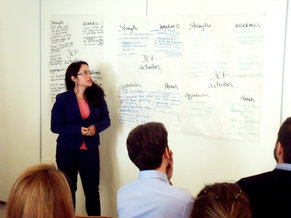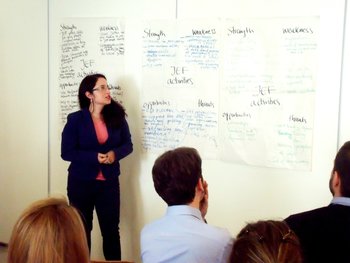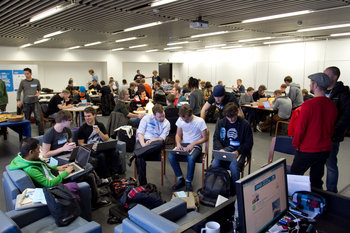
Quality
The local competition of a sandwich shop use low quality bread in their sandwiches, there is an opportunity for the shop to be the only place in town with decent bread.Customer Perceptions
Customers perceive a common ingredient in peanut butter to be unhealthy. This represents an opportunity for a peanut butter manufacturer to formulate products that are perceived as more healthy.Customer Needs
Underserved customer needs. For example, a lack of charging stations in an environment of high sales of electric vehicles.Customer Preferences
Customer preferences such as an opportunity to open a restaurant that offers healthy food at an airport that currently only sells junk food.Demographics
Changing demographics such as an aging population that represents an opportunity for accessible, easy-to-use and simplified technology products.Customer Service
Customer service failures of a competitor are an opportunity to offer customers something better. For example, a telecom company with an antagonistic relationship with customers and a broken service culture is vulnerable to competition that is more friendly and easy to deal with.Pricing
A competitor that charges high prices such that they are vulnerable to price competition. For example, an event ticket distribution company that charges high fees may be an opportunity for technology companies to offer a similar service at a lower price.Costs
An opportunity to reduce costs below that of a competitor. For example, an organic farmer who is able to produce at greater scale and improve yield using techniques such as companion planting may achieve lower unit costs than all competition. In a commodity industry, lower cost is the primary type of competitive advantage.Talent
Hiring or developing talent. For example, a graphic design firm that opens in a town where most of the competition aren't very creative, skilled or innovative may have an opportunity to dominate the market based on superior talent.Knowledge
Developing know-how such as a sales team that develops a process for detecting prospects who will make a significant purchase in the next 6 months. This may be a competitive advantage if the competition use less accurate methods for evaluating prospects.Innovation
Innovation is a leap forward that disrupts the status quo. These are usually non-obvious and difficult to identify. Opportunities for innovation occur where an industry hasn't changed in a meaningful way for many years and is vulnerable to innovation due to inefficiency, economic bads or customer satisfaction issues.Branding
An opportunity to use brand recognition and image to make gains against a competitor with a weaker brand.Promotion
Using promotion techniques such as advertising to build brand recognition and image. For example, an organic food products company finds that the competition don't advertise such that there is an opportunity to establish top of mind brand recognition with advertising campaigns.Organizational Culture
If a competitor has a toxic organizational culture, there may be an opportunity to provide a more pleasant and creative environment that attracts talent and improves productivity.Distribution
An opportunity to reach more customers. For example, a competitor goes out of business and there is an opportunity to expand into markets that are newly underserved.Partnerships
The opportunity to create and leverage new relationships. For example, an opportunity to distribute your products in Germany with a sales partnership.Technology
Technological advancements that make new things possible. For example, advancements in robotics and computing that make it possible to automate processes and tasks.Environment
An opportunity to do things in a more environmentally responsible way than the competition. This is an increasingly common and valuable form of competitive advantage that can improve the perceived value of your products.Diversification
An opportunity to enter new markets such as a restaurant owner who considers opening a cafe to compete on food items.Mergers & Acquisitions
An opportunity to buy or merge with a competitor. For example, a farmer who buys an adjacent farm to scale up production.Financial Conditions
Advantageous financial conditions such as a growing economy, low interest rates and a low exchange rate. For example, a farmer in Korea who buys a German machine for sorting apples when exchange rates are usually good for making a purchase in euros with won.Investment
Opportunities to put money to work such as investing in capital improvements to a business. For example, a farmer who buys more efficient equipment to boost output.Reputation
Opportunities to improve your reputation or leverage a good reputation. For example, a bicycle helmet brand that is known for its safety may advertise their commitment to safety to capitalize on bad publicity surrounding the safety of a competitor's product.Types
SWOT opportunities are external factors that can be leveraged to your benefit. The following are common types of SWOT opportunity.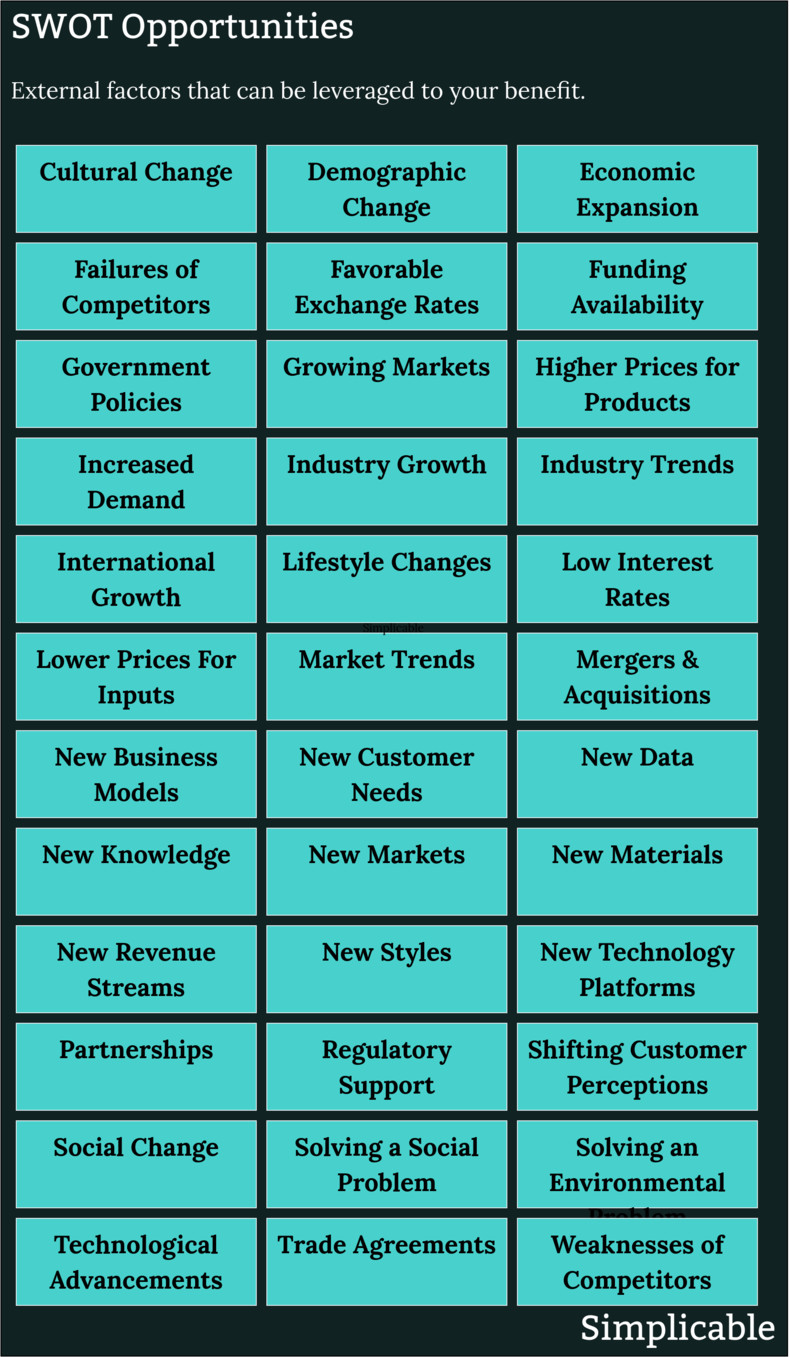
Summary
SWOT opportunities are changes or situations in your external environment that you can leverage to your advantage. Often a problem can be an opportunity in the sense that you can offer some type of solution for the problem.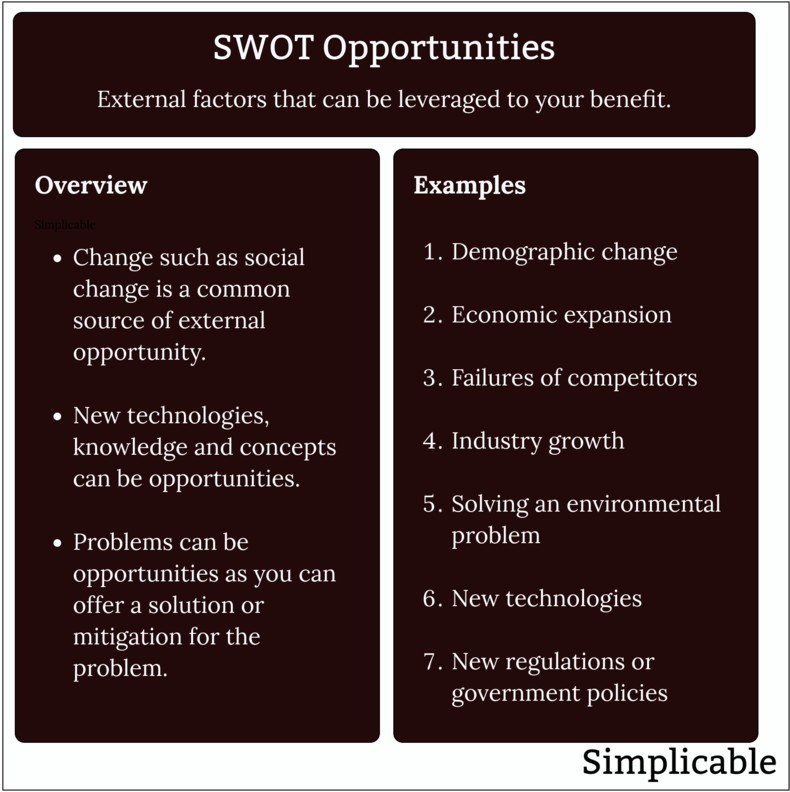
| Overview: SWOT Opportunities | ||
Type | ||
Definition | A positive external condition that can work to your favor | |
Related Concepts | ||







